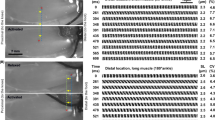Summary
Light diffraction patterns produced byLimulus striated muscle fibers were examined. Segments of fibers were glycerinated, fixed or bathed in relaxing solution. Profiles of the intensity of a diffracted order vs. the angle of incidence of the laser beam often exhibited narrow peaks with the fiber at rest length. The incident angles at which the intensity of left and right orders is greatest are used to calculate the sarcomere length, supporting the notion that regions of the fiber are organised into Bragg reflecting planes. These profiles developed subpeaks and broadened upon stretch of the fiber. The broad angle scan profiles are suggested to result from a decrease in the regular packing of myofibrils as the fiber is lengthened. The angular width of the subpeaks is used to estimate the thickness of clusters of myofibrils. The variation in sarcomere length along the fiber, as determined by the 0th to 1st diffraction order spacing, was dependent upon the fiber preparation. Glycerinated fibers and those bathed in relaxing solution showed more variation than fixed fibers. The variation of sarcomere length is compared to the variation in thick filament lengths inLimulus reported by Dewey et al. (1982) lengths inLimulus reported by Dewey et al. (1982). These results are compared to those obtained from frog fiber segments.
Similar content being viewed by others
References
Baskin RJ, Lieber RL, Oba T, Yeh Y (1981) Intensity of light diffraction from striated muscle as a function of incident angle. Biophys J 36:759–773
Baskin RJ, Burton K, Yeh Y, Corcoran M (1983) Light diffraction studies ofLimulus muscle fibers. Biophys J 41:32a
Betz W, Sakmann B (1973) Effects of proteolytic enzymes on function and structure of frog neuromuscular junctions. J Physiol 230:673–688
Cleworth DR, Edman KAP (1972) Changes in sarcomere length during isometric tension development in frog skeletal muscle. J Physiol 227:1–17
de Villafranca GW, Marschhaus CE (1963) Contraction of the A band. J Ultra Res 9:156–165
Davidheiser S, Levine R, Davies R (1982) Two different fiber types inLimulus telson mucle. Fed Proc 41:1522
Dewey M, Blasie K, Levine R, Colflesh D (1972) Changes in A-band structure during shortening of a paramyosin-containing striated muscle. Biophys J 12:82a
Dewey M, Levine R, Coleflesh D (1973) Structure ofLimulus striated muscle. The contractile apparatus at various sarcomere lengths. J Cell Biol 58:574–593
Dewey M, Colflesh D, Brink P, Fan S-F, Gaylinn B, Gural N (1982) Structural, functional, and chemical changes in the contractile apparatus ofLimulus striated muscle as a function of sarcomere shortening and tension development. In: Twarog B, Levine R, Dewey M (eds) Basic biology of muscles: a comparative approach. Raven Press, New York, pp 53–72
Dewey M, Brink P, Colflesh DE, Gaylinn B, Fan S-F, Anapol F (1984)Limulus striated muscle provides an unusual model for muscle contraction. In: Pollack G, Sugi H (eds) Contractile mechanisms in muscle (Advances in experimental medicine and biology, vol 170). Plenum Press, New York, p 93
Fourtner C, Sherman R (1972) A light and electron microscopic examination of muscles in the walking legs of the horseshoe crab,Limulus polyphemus (L). Can J Zool 50:1447–1455
Franzini-Armstrong C (1970) Natural variability in the length of thin and thick filaments in single fibres from a crab,Portunas depurator. J Cell Sci 6:559–592
Fujime S (1984) An intensity expression of optical diffraction from striated muscle fibers. J Muscle Res Cell Motil 5:577–587
Huxley AF Peachey LD (1961) The maximum length for contraction in vertebrate striated muscle. J Physiol 156:150–165
Huxley AF (1980) Reflections on muscle. Princeton Univ Press, Princeton, pp 60–61
Kawai M, Kuntz I (1973) Optical diffraction studies of muscle fibers. Biophys J 13:857–876
Leung Af (1982) Laser diffraction of single intact cardiac muscle cells at rest. J Muscle Res Cell Motil 3:399–418
Leung AF (1983) Determination of myofibrillar diameter by light diffractometry. Pflügers Arch 396:238–242
Leung AF (1984) Fine structures in the light diffraction pattern of striated muscle. J Muscle Res Cell Motil 5:535–558
Lieber RL, Yeh Y, Baskin RJ (1984) Sarcomere length determination using laser diffraction: the effect of beam and fiber diameter. Biophys J 45:1007–1016
Paolini PJ, Sabbadini R, Roos KP, Baskin RJ (1976) Sarcomere length dispersion in single skeletal muscle fibers and fiber bundles. Biophys J 16:919–930
Rome E (1967) Light and X-ray diffraction studies of the filament lattice of glycerol-extracted rabbit psoas muscle. J Mol Biol 27:591–602
Rudel R, Zite-Ferenczy F (1979a) Do laser diffraction studies on striated muscle indicate stepwise sarcomere shortening? Nature 278:573–575
Rudel R, Zite-Ferenczy F (1979b) Interpretation of light diffraction by cross-striated muscle as Bragg reflexion of light by the lattice of contractile proteins. J Physiol 290:317–330
Rudel R, Zite-Ferenczy F (1980) Efficiency of light diffraction by cross-striated muscle fibers under stretch und during isometric contraction. Biophys J 30:507–516
Sandow A (1936) Diffraction patterns of the frog sartorius and sarcomere behavior under stretch. J Cell Comp Physiol 9:37–54
Sundell CL, Goldman YE, Peachey LD (1985) Microstructure in near-field and far-field laser diffraction patterns of muscle fibers. Biophys J 47:383a
Tameyasu T, Ishide N, Pollack GH (1982) Discrete sarcomere length distribution in skeletal muscle. Biophys J 37:489–492
Walcott B, Dewey M (1980) Length-tension relation inLimulus striated muscle. J Cell Biol 87:204–208
Wray J, Vibert P, Cohen C (1974) Cross-bridge arrangements inLimulus muscle. J Mol Biol 88:343–348
Yeh Y, Baskin RJ, Lieber RL, Roos KP (1980) Theory of light diffraction by single skeletal muscle fibers. Biophys J 29:509–522
Author information
Authors and Affiliations
Rights and permissions
About this article
Cite this article
Burton, K., Baskin, R.J. Light diffraction patterns and sarcomere length variation in striated muscle fibers ofLimulus . Pflugers Arch. 406, 409–418 (1986). https://doi.org/10.1007/BF00590945
Received:
Accepted:
Published:
Issue Date:
DOI: https://doi.org/10.1007/BF00590945




